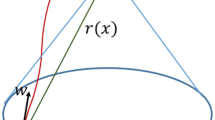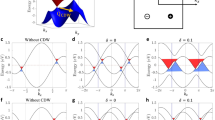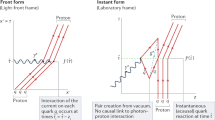Abstract
Physical theories have their most fundamental expression as action integrals. This suggests that the total action of the Universe is the most fundamental physical quantity, and hence finite. In this article it is argued that finite universal action implies that the Universe is spatially closed. Further, the possible spatial topologies, the types of matter that can dominate the early universe dynamics, and the form of any quadratic additions to the lagrangian of general relativity are constrained. Initial and final cosmological curvature singularities are required to avoid a universal action singularity.
This is a preview of subscription content, access via your institution
Access options
Subscribe to this journal
Receive 51 print issues and online access
$199.00 per year
only $3.90 per issue
Buy this article
- Purchase on Springer Link
- Instant access to full article PDF
Prices may be subject to local taxes which are calculated during checkout
Similar content being viewed by others
References
Planck, M. Scientific Autobiography and Other Papers pp. 48, 180 (Greenwood, New York, 1968).
Barrow, J. D. & Tipler, F. J. The Anthropic Cosmological Principle (Oxford University Press, 1986).
Dirac, P. A. M. in Selected Papers on Quantum Electrodynamics (ed. Schwinger, J.) 312–320 (Dover, 1958).
Ramond, P. Field Theory: A Modern Primer (Benjamin, New York, 1981).
Green, M. B., Schwarz, J. H. & Witten, E. Superstring Theory Vol. 1 (Cambridge University Press, 1987).
Jaffe, A. & Taubes, C. Vortices and Monopoles: the Structure of Static Gauge Theories (Birkhäuser, Boston, 1980).
Freed, D. S. & Uhlenbeck, K. Instantons and Four-Manifolds (Springer, Berlin, 1984).
Coleman, S. in The Whys of Subnuclear Physics (ed. Zichichi, A.) 805–941 (Plenum, New York, 1979).
DeWitt, B. S. in Relativity, Groups, and Topology (eds DeWitt, C. & DeWitt, B. S.) 587–820 (Gordon & Breach, New York, 1964).
York, J. M. Phys. Rev. Lett. 28, 1082–1084 (1972).
Gibbons, G. W. & Hawking, S. W. Phys. Rev. D15, 2752–2756 (1977).
Hawking, S. W. in General Relativity: An Einstein Centenary Survey (eds Hawking, S. W. & Israel, W.) 746–789 (Cambridge University Press, 1979).
Hawking, S. W. & Ellis, G. F. R. The Large-scale Structure of Space-time (Cambridge University Press, 1973).
Narlikar, J. V. Astrophys. Astr. 5, 67–78 (1984).
Gott, J. R. Nature 295, 304–306 (1982).
Guth, A. Phys. Rev. D23, 347–356 (1981).
Linde, A. D. Phys. Lett. 175B, 395–400 (1986).
Barrow, J. D., Galloway, G. J. & Tipler, F. J. Mon. Not. R. astr. Soc. 223, 835–844 (1986).
Tipler, F. J. in Proc. 13th Texas Symposium on Relativistic Astrophysics (ed. Ulmer, M. P.) (World Scientific, Singapore, 1987).
Tipler, F. J. in Proc. 26th Liège Astrophysical Colloquium (ed. Demaret, J.) (Liège Observatory Press, Liège, 1987).
Barrow, J. D. & Matzner, R. A. Phys. Rev. D21, 336–340 (1980).
Tipler, F. J., Clarke, C. J. S. & Ellis, G. F. R. in General Relativity and Gravitation Vol. 2 (ed. Held, A.) 97–206 (Plenum, New York, 1980).
Christodoulou, D. Commun. math. Phys. 105, 337–361 (1986).
Yodzis, P., Seifert, H. J. & Müller zum Hagen, H. Commun. math. Phys. 37, 29–40 (1974).
Weinberg, S. Gravitation and Cosmology (Wiley, New York, 1972).
Gurevich, L. E., Finkelstein, A. M. & Ruban, V. A. Astrophys. Space Sci. 22, 231–242 (1973).
Barrow, J. D. Nature 272, 211–215 (1978).
Kantowski, R. & Sachs, R. K. J. Math. Phys. 7, 443–446 (1966).
Brill, D. R. Phys. Rev. 133, 845–848 (1964).
Perry, M. J. Phys. Lett. 71B, 234–236 (1977).
Bonnor, W. Mon. Not. R. astr. Soc. 167, 55–65 (1974).
Szekeres, P. Commun. math. Phys. 41, 55–64 (1975).
Bonnor, W. B. & Tomimura, N. Mon. Not. R. astr. Soc. 175, 85–94 (1976).
Belinskii, V. A. Soc. Phys. JETP 50, 623–631 (1979).
Barrow, J. D. & Ottewill, A. J. Phys. A16, 2757–2775 (1983).
Barrow, J. J. & Tipler, F. J. Mon. Not. R. astr. Soc. 216, 395–402 (1985).
Author information
Authors and Affiliations
Rights and permissions
About this article
Cite this article
Barrow, J., Tipler, F. Action principles in nature. Nature 331, 31–34 (1988). https://doi.org/10.1038/331031a0
Received:
Accepted:
Issue Date:
DOI: https://doi.org/10.1038/331031a0
This article is cited by
-
On black hole thermodynamics, singularity, and gravitational entropy
General Relativity and Gravitation (2022)
-
Probing the Information-Probabilistic Description
International Journal of Theoretical Physics (2022)
Comments
By submitting a comment you agree to abide by our Terms and Community Guidelines. If you find something abusive or that does not comply with our terms or guidelines please flag it as inappropriate.



